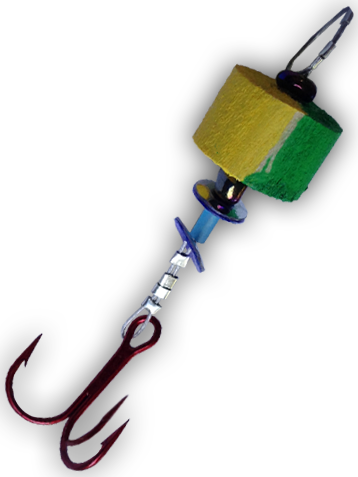The advantages of a braided coated steel wire
Any new lure must address the three major concerns of line connection, vibration and color. A good fisherman knows that it's not only the lure but how it is tied to the line that has a direct impact on the fish you catch. If you're catching mackerel, pike or barracuda you'd better have some steel as nylon will be cut by these aggressive, strong and sharp toothed animals. On the other hand, a fisherman going for trout, steelhead and river salmon know that fluorocarbon, line size, color and size of the swivel can directly affects the interest a fish may have in the terminal tackle.
In that context, another factor is how these things affect natural motion. For example, a heavier line weight will stiffen the presentation. A swivel that is too big may spook the fish or make the lure behave unlike what was originally desired. Some lures (for example, small spinners such as Mepps or Wordens) have a hard wire that, if bent, may negatively impact the lure action, or even render it unusable.
The solution to all of these problems, I have found, is a coated beraided steel wire.
- A coated, braided wire is extremely strong – much stronger than an equivalent monofilament or fluorocarbon.
- A coated braided wire is also rust resistant and resists abrasion very well. More importantly however, the wire is flexible, so the lure all of sudden has a swagger upon retrieve that a hard wired lure won't have. That subtle flex is ever important. Often when a lure first hits the water – the way it drops can induce a strike or call in a fish. The flexibility in the wire is what creates the motion as it drops and upon retrieve.
- The coated braided wire for the lure also combines the flexibility and small size to attract more visually cautious fish yet provides the resistance needed when fighting through weedy areas and toothy fish.
- Lastly the coated braided wire creates a direct connection from the fishing line to the hook. You can just feel the bites better, and that increases your hook up rates. That is where the name Full Shank comes from – much like a full tang in a knife or full shank in a shoe – we are talking about metal going through the item thus improving sensitivity, quality and strength.
the importance of flash, color & vibration
The second goal was to create vibration and color/pattern to produce aggressive bites. The lure uses a deceptively simple technique for this. First we need to understand how spinners work. Spinners create vibration – very important as that is a signal that fish recognizes. Spinners also create flash of colors – I mostly use nickel finish a silver flash common with bait fish. The idea with the bright color barrel in the front is that the spinner goes in front of it and creates an alternating flash of color and silver. So there is literally a "blinking effect" that fish can see, and that broadcasted color and flash is irresistible to many fish. Lastly the glass beads add minute sounds and vibrations as the lure vibrates and they also shine.
So at this point this lure has been tested and attracts big bass, and despite the size 6 VMC blood red treble hook it also hooks into some panfish.


